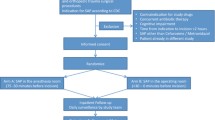Abstract
The most important principle in surgical antibiotic prophylaxis is to ensure high blood levels of antibiotic at the time of anticipated wound contamination. This is best achieved by intravenous administration commenced at the time of induction of anesthesia. The continued efficacy of prophylaxis depends on the implementation of policies that minimize the opportunities for bacteria to acquire resistance to antibiotics. Prophylaxis should, therefore, be used judiciously and restricted to operations for which it is of established benefit. These are mainly operations in which a viscus colonized by bacteria is opened and in which bacterial contamination is unavoidable. Prophylaxis is also used for certain cardiovascular and orthopedic implant operations in which septic complications are a major threat to a successful outcome and to the life of the patient. The choice of antibiotic should be based on knowledge of the bacterial species likely to contaminate the wound and cause infection. The duration of prophylaxis should be short, and should not be extended beyond the minimum period known to be effective. Controlled trials have established that a single dose of antibiotic is sufficient for many operative procedures and that there is no benefit in prolonging prophylaxis beyond the period when the open wound is exposed to bacterial contamination.
Résumé
Le principe fondamental de l'antibiothérapie prophylactique correspond à la nécessité d'obtenir la plus haute saturation possible du sang en antibiotiques au moment ou le risque de contamination est le plus grand. Pour ce faire il convient d'administrer l'antibiotique par voie intra-veineuse au moment de l'induction anesthésique. Pour que l'antibiothérapie prophylactique garde sa valeur il convient de réduire l'emploi excessif des antibiotiques qui ne peut conduire qu'à accentuer la résistance des germes. L'antibiothérapie prophylactique ne concerne donc que des cas bien définis ou elle est indispensable. Il en est ainsi des interventions exposées à la contamination microbienne lors de l'ouverture d'un viscère creux. Il en est de même des interventions cardiovasculaires et des interventions orthopédiques qui nécessitent l'emploi de matériel prothétique.
Le choix de l'antibiotique a employer repose sur la connaissance exacte des germes susceptibles de provoquer l'infection pour une intervention donnée.
L'antibiothérapie prophylactique doit être de courte durée. Elle ne doit pas dépasser le temps bien déterminé ou elle est efficace.
Des essais contrôlés ont permis d'établir qu'une seule dose d'antibiotiques est suffisante et qu'il n'est d'aucun intérêt de prolonger l'antibiothérapie au delà du temps de la contamination.
Similar content being viewed by others
References
Howe, C.W.: The problem of post-operative wound infections caused byStaphylococcus aureus. Ann. Surg.146:384, 1957
Report: Aseptic methods in the operating suite. Lancet1:705; 763; 831, 1977
Report: Incidence of surgical wound infection in England and Wales. Lancet2:659, 1960
National Research Council: Post-operative wound infections, the influence of ultraviolet irradiation of the operating room and various other factors. Ann. Surg.160(Suppl.):1, 1964
Cruse, P.J.E.: Incidence of wound infection on the surgical services. Surg. Clin. North Am.55:1269, 1975
Lowbury, E.J.L., Lilly, H.A., Ayliffe, G.A.J.: Preoperative disinfection of surgeon's hands: Use of alcoholic solutions and effects of gloves on skin flora. Br. Med. J.4:369, 1974
Lilly, H.A., Lowbury, E.J.L.: Disinfection of the skin: Assessment of some new preparations. Br. Med. J.3:674, 1971
Parker, M.T.: Post-operative clostridial infections in Britain. Br. Med. J.3:671, 1969
Donovan, I.A., Ellis, D., Gatehouse, D., Little, G., Grimley, R., Armistead, D., Keighley, M.R.B., Strachan, C.J.L.: One-dose antibiotic prophylaxis against wound infection after appendicectomy: A randomised trial of clindamycin, cefazolin sodium and a placebo. Br. J. Surg. 66:193, 1979
Eykyn, S.J., Jackson, B.T., Lockhart-Mummery, H.E., Phillips, I.: Prophylactic pre-operative intravenous metronidazole in elective colorectal surgery. Lancet2:761, 1979
Polk, P.E., Tager, I.B., Shapiro, M., Goren-White, B., Goldstein, P., Schoenbaum, S.C.: Randomised clinical trial of perioperative cefazolin in preventing infection after hysterectomy. Lancet1:437, 1980
Miles, A.A., Miles, E.M., Burke, J.: The value and duration of defense reactions of the skin to the primary lodgement of bacteria. Br. J. Exp. Pathol.38:79, 1957
Burke, J.: The effective period of preventive antibiotic action in experimental incisions and dermal lesions. Surgery50:161, 1961
Edlich, R.F., Smith, Q.T., Edgerton, M.T.: Resistance of the surgical wound to antimicrobial prophylaxis and its mechanism of development. Am. J. Surg.126:583, 1973
Fullen, W.D., Hunt, J., Altemeier, W.A.: Prophylactic antibiotics in penetrating wounds of the abdomen. J. Trauma12:282, 1972
Stone, H.H., Hooper, C.A., Kolb, L.D., Geheber, C.E., Dawkins, E.J.: Antibiotic prophylaxis in gastric, biliary and colonic surgery. Ann. Surg.184:443, 1976
Chodak, G.W., Plaut, M.E.: Use of systemic antibiotics for prophylaxis in surgery. Arch. Surg.112:326, 1977
Hares, M.D., Hegarty, M.A., Warlow, J., Malins, D., Youngs, D., Bentley, S., Burdon, D.W., Keighley, M.R.B.: A controlled trial to compare systemic and intra-incisional cefuroxime prophylaxis in high risk gastric surgery. Br. J. Surg.68:276, 1981
Mitchell, N.J., Evans, D.S., Pollock, D.: Pre-operation single-dose cefuroxime antimicrobial prophylaxis with and without metronidazole in elective gastrointestinal surgery. J. Antimicrob. Chemother.6:393, 1980
Strachan, C.J.L., Black, J., Powis, S.J.A., Waterworth, T.A., Wise, R., Wilkinson, A.R., Burdon, D.W., Severn, M., Mitra, B., Norcott, H.: The prophylactic use of cephazolin against wound sepsis after cholecystectomy. Br. Med. J.1:1254, 1977
Morran, C., McNaught, W., McArdle, C.S.: Prophylactic co-trimoxazole in biliary surgery. Br. Med. J.2:462, 1978
Higgins, A.F., Lewis, A., Noone, P., Hole, M.L.: Single and multiple dose co-trimoxazole and metronidazole in colorectal surgery. Br. J. Surg.67:90, 1980
Nichols, R.L., Condon, R.E., Gorbach, S.L., Nyhus, L.M.: Efficacy of pre-operative antimicrobial preparation of the bowel. Ann. Surg.176:227, 1972
Arabi, Y., Dimock, F., Burdon, D.W., AlexanderWilliams, J., Keighley, M.R.B.: Influence of bowel preparation and antimicrobials on colonic microflora. Br. J. Surg.65:555, 1978
Keighley, M.R.B., Arabi, Y., Alexander-Williams, J., Youngs, D., Burdon, D.W.: Comparison between systemic and oral antimicrobial prophylaxis in colorectal surgery. Lancet1:894, 1979
Condon, R.E., Bartlett, J.G., Nichols, R.L., Schulte, W.J., Gorbach, S.L., Ochi, S.: Pre-operative prophylactic cephalothin fails to control septic complications of colorectal operations: Results of controlled clinical trial. Am. J. Surg.137:68, 1979
Author information
Authors and Affiliations
Rights and permissions
About this article
Cite this article
Burdon, D.W. Principles of antimicrobial prophylaxis. World J. Surg. 6, 262–267 (1982). https://doi.org/10.1007/BF01653540
Issue Date:
DOI: https://doi.org/10.1007/BF01653540




